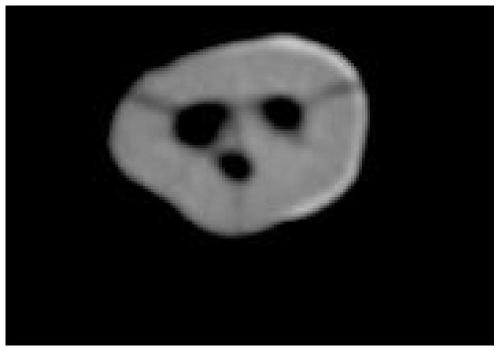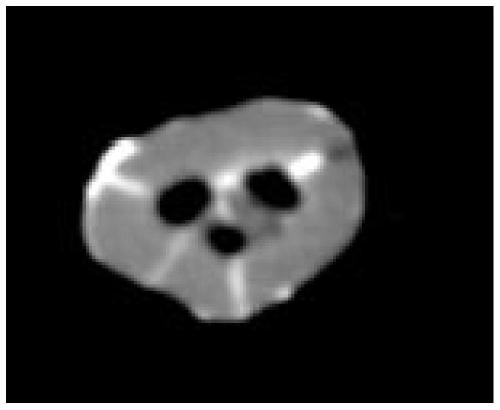A Method for Detecting Fractures and Cracks of Cracked Teeth Using Image Intensifier and Cone Beam CT Imaging Technology
A technology of image enhancement and CT imaging, which is applied in the fields of radiological diagnosis instruments, applications, dental radiological diagnosis, etc., and can solve problems such as affecting the diagnostic accuracy.
- Summary
- Abstract
- Description
- Claims
- Application Information
AI Technical Summary
Problems solved by technology
Method used
Image
Examples
Embodiment 1
[0015] A method of using image intensifier and cone-beam CT imaging technology to detect fractures and cracks in cracked teeth: use the enhanced contrast agent diatrizoate to enhance the cracks, wait for the contrast agent to penetrate into the cracks, and quickly pass through cone-beam CT imaging To judge the location and depth of cracks in cracked teeth, and distinguish them from the linear low-density artifacts formed by root canal fillings.
[0016] When the cracked tooth belongs to the third type of cracked tooth, the detection method is: apply 30%-40% meglumine diatrizoate on the surface of the cracked tooth with a cotton swab, and apply it repeatedly on the surface of the cracked tooth. After 10 minutes, wait for the contrast agent to penetrate into the crack Afterwards, the cracked teeth were scanned with conventional-dose cone-beam CT scanning, and the position and nature of the cracks were determined by contrast agent-enhanced images of the cracks.
Embodiment 2
[0018] A method of using image intensifier and cone-beam CT imaging technology to detect fractures and cracks in cracked teeth: use the enhanced contrast agent diatrizoate to enhance the cracks, wait for the contrast agent to penetrate into the cracks, and quickly pass through cone-beam CT imaging To judge the location and depth of cracks in cracked teeth, and distinguish them from the linear low-density artifacts formed by root canal fillings.
[0019] When the cracked teeth belong to the four types of vertically fractured teeth, the detection method is: use a fine needle tube with a diameter of 0.2mm to extract 0.5ml of diatrizoate meglumine at the crack or inject it under pressure in the medullary cavity, After waiting for 10 minutes, CBCT routine dose detection was performed to determine the position of the fracture line of the longitudinally fractured tooth.
Embodiment 3
[0021] A method of using image intensifier and cone-beam CT imaging technology to detect fractures and cracks in cracked teeth: use the enhanced contrast agent diatrizoate to enhance the cracks, wait for the contrast agent to penetrate into the cracks, and quickly pass through cone-beam CT imaging To judge the location and depth of cracks in cracked teeth, and distinguish them from the linear low-density artifacts formed by root canal fillings.
[0022] When the cracked tooth is a tooth with five types of vertical root fracture, the detection method is: remove the filling in the pulp cavity and the upper part of the root canal, and use a fine needle tube with a diameter of 0.2mm to extract 50%-60% of the crack that occurred on the root. 1ml of diatrizoate meglumine was injected under pressure in the medullary cavity, and after waiting for 10 minutes, after the contrast agent penetrated into the crack, it was quickly developed by cone-beam CT imaging to judge whether there was a...
PUM
 Login to View More
Login to View More Abstract
Description
Claims
Application Information
 Login to View More
Login to View More - R&D
- Intellectual Property
- Life Sciences
- Materials
- Tech Scout
- Unparalleled Data Quality
- Higher Quality Content
- 60% Fewer Hallucinations
Browse by: Latest US Patents, China's latest patents, Technical Efficacy Thesaurus, Application Domain, Technology Topic, Popular Technical Reports.
© 2025 PatSnap. All rights reserved.Legal|Privacy policy|Modern Slavery Act Transparency Statement|Sitemap|About US| Contact US: help@patsnap.com


